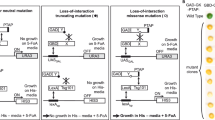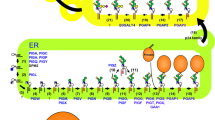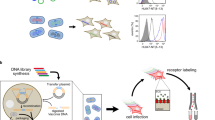Abstract
PLASMA membranes of most animal cells respond to specific hormonal signals by synthesising adenosine 3′,5′ cyclic monophosphate (cyclic AMP) from ATP, a reaction catalysed by adenylate cyclase. The precise molecular basis of this membrane response has not been defined. In particular, we do not know the number of molecular species required for transduction of hormonal signals into stimulation of cyclic AMP synthesis. Catalytic adenylate cyclase and specific hormone binding activities can be separated on the basis of their physical properties1–3. However, hormonal stimulation may require one or more other molecules necessary for coupling the two activities in membranes. One of these may contain a guanyl nucleotide regulatory site, as guanyl trinucleotides are strictly required for hormonal stimulation of cyclase in several membrane systems4–8. Genetic complementation analysis can help to define the minimum number of gene products involved in a complex biochemical function. Although subject to qualifications, the principle is simple : if a cross between two mutant cells bearing a recessive phenotype fails to reconstitute the wild-type (WT or normal) phenotype, both mutant parental cells must bear a lesion in a common gene product; if the cross produces a WT phenotype, the two parental mutations must affect different gene products. Here we apply this method of analysis to the hormone-sensitive cyclase system of the S49 lymphoma tissue culture line, in which two distinct classes of variant clones with stable deficiencies in hormonal stimulation of cyclase have been selected9–10. We have constructed viable hybrid clones by crossing each of these variants with WT, and with each other. We describe the resulting hybrid phenotypes and their implications regarding the molecular components of hormone-sensitive adenylate cyclase.
This is a preview of subscription content, access via your institution
Access options
Subscribe to this journal
Receive 51 print issues and online access
$199.00 per year
only $3.90 per issue
Buy this article
- Purchase on Springer Link
- Instant access to full article PDF
Prices may be subject to local taxes which are calculated during checkout
Similar content being viewed by others
References
Limbird, L. E. & Lefkowitz, R. J. J. biol. Chem. 252, 799–802 (1977).
Haga, T., Haga, K. & Gilman, A. G. J. biol. Chem. 252, 5776–5782 (1977).
Welton, A. F. et al. J. biol. Chem. 252, 5447–5950 (1977).
Rodbell, M., Birnbaumer, L., Pohl, S.L. & Krans, H. M. J. J. biol. Chem. 246, 1877–1882 (1971).
Rodbell, M., Lin, M. C. & Salomon, Y. J. biol. Chem. 249, 59–65 (1974).
Bilizekian, J. P. & Aurbach, G. D. J. biol. Chem. 249, 157–161 (1974).
Londos, C. et al. Proc. natn. Acad. Sci. U.S.A. 71, 3087–3090 (1974).
Ross, E. M., Maguire, M. E., Sturgill, T. W., Biltonen, R. L. & Gilman, A. G. J. biol. Chem. 252, 5761–5775 (1977).
Bourne, H. R., Coffino, P. & Tomkins, G. M. Science 187, 750–752 (1975).
Haga, T. Y., Ross, E. M., Anderson, H. J. & Gilman, A. G. Proc. natn. Acad. Sci. U.S.A. 74, 2016–2020 (1977).
Johnson, G. L. & Bourne, H. R. Biochem. biophys. Res. Commun. 78, 792–798 (1977).
Insel, P. A. et al. Molec. Pharmac. 12, 1062–1069 (1976).
Gefter, M. L., Margulies, D. H. & Scharff, M. D. Somatic Cell Genet. 3, 231–236 (1977).
Lemaire, I. & Coffino, P. J. Cell Physiol. 92, 437–446 (1977).
Gilman, A. G. Proc. natn. Acad. Sci. U.S.A. 67, 305–312 (1970).
Bourne, H. R., Coffino, P. & Tomkins, G. M. J. Cell Physiol. 85, 611–620 (1975).
Ross, E. M. & Gilman, A. G. Proc. natn. Acad. Sci. U.S.A. 74, 3715–3719 (1977).
Ross, E. M. & Gilman, A. G. J. biol. Chem. 252, 6966–6969 (1977).
Cassel, D. & Selinger, Z. J. cyclic Nucleotide Res. 3, 11–22 (1977).
Author information
Authors and Affiliations
Rights and permissions
About this article
Cite this article
NAYA-VIGNE, J., JOHNSON, G., BOURNE, H. et al. Complementation analysis of hormone-sensitive adenylate cyclase. Nature 272, 720–722 (1978). https://doi.org/10.1038/272720a0
Received:
Accepted:
Issue Date:
DOI: https://doi.org/10.1038/272720a0
Comments
By submitting a comment you agree to abide by our Terms and Community Guidelines. If you find something abusive or that does not comply with our terms or guidelines please flag it as inappropriate.



